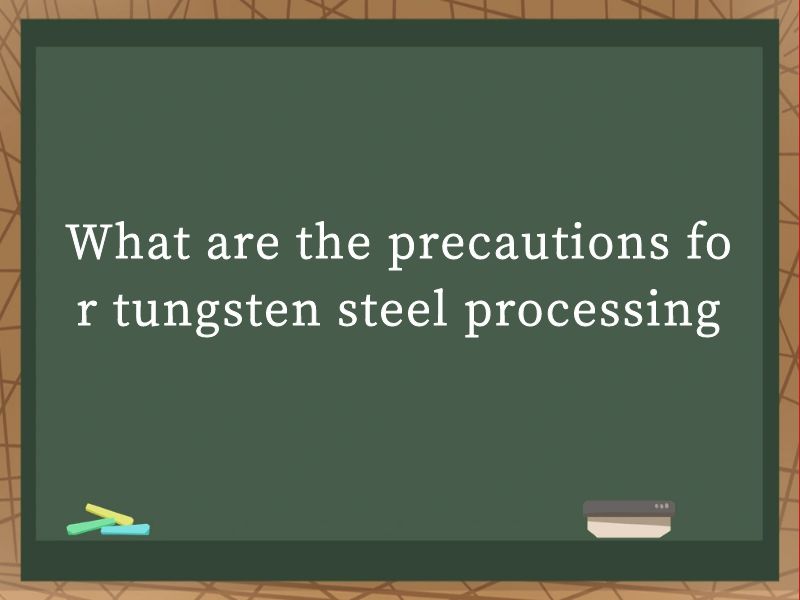JOURNALISM
- NEWS -
|
What are the precautions for tungsten steel processingWhat are the precautions for tungsten steel processing.Tungsten steel, known for its exceptional hardness, wear resistance, and high-temperature stability, is widely utilized in various industries, including tooling, cutting tools, and wear-resistant parts. However, processing tungsten steel can be challenging due to its hardness and brittleness. To ensure successful and efficient machining, it is crucial to follow specific precautions and best practices. This article delves into the precautions necessary for tungsten steel processing, highlighting critical aspects such as material preparation, tool selection, machining parameters, cooling and lubrication, and post-processing considerations.
1. Material Preparation 1.1 Inspection and Pre-treatment Before initiating the processing of tungsten steel, thorough inspection of the raw material is essential. Check for cracks, inclusions, and other defects that could compromise the final product's integrity. It is advisable to conduct non-destructive testing (NDT) such as ultrasonic or magnetic particle inspection to detect internal flaws. Pre-treatment steps, such as annealing, can help relieve internal stresses and improve machinability. Annealing involves heating the material to a specific temperature and then cooling it slowly, which can soften the material slightly and make it more ductile. This process reduces the risk of cracking during machining. 1.2 Material Handling Due to its high density and hardness, tungsten steel can be challenging to handle. Proper lifting techniques and equipment, such as vacuum lifters or magnetic chucks, should be used to avoid damage to both the material and personnel. Additionally, protective gloves and eyewear should be worn to safeguard against sharp edges and flying debris. 2. Tool Selection 2.1 Tool Material The choice of cutting tools is critical when processing tungsten steel. Carbide tools, ceramic tools, and cubic boron nitride (CBN) tools are commonly used due to their ability to withstand high temperatures and maintain cutting edges under severe conditions. Carbide Tools: Tungsten carbide tools are hard and wear-resistant, making them suitable for roughing and semi-finishing operations. Ceramic Tools: Ceramic tools offer higher hardness and better thermal stability than carbide, making them ideal for finishing operations. CBN Tools: Cubic boron nitride tools are extremely hard and retain their cutting edge well, suitable for precision machining of tungsten steel. 2.2 Tool Geometry The geometry of the cutting tools, including rake angle, relief angle, and flute design, should be optimized for tungsten steel machining. A larger rake angle reduces cutting forces and temperatures, while a larger relief angle helps prevent tool breakage. Flute design is crucial for effective chip evacuation and heat dissipation. 3. Machining Parameters 3.1 Cutting Speeds and Feeds Selecting appropriate cutting speeds and feeds is vital for efficient and successful tungsten steel processing. Generally, lower cutting speeds and higher feeds are used compared to softer materials to avoid excessive heat generation and tool wear. Cutting Speed: Typically, cutting speeds for tungsten steel range from 50 to 150 meters per minute (m/min), depending on the tool material and the specific machining operation. Feed Rate: Feed rates are usually set between 0.05 to 0.3 millimeters per revolution (mm/rev), again depending on the specific conditions and the desired surface finish. 3.2 Depth of Cut The depth of cut should be kept as shallow as possible to minimize cutting forces and reduce the risk of tool failure. Gradually increasing the depth of cut as the tool wears can help maintain a consistent cutting action. 4. Cooling and Lubrication 4.1 Importance of Cooling Effective cooling and lubrication are essential to dissipate heat, reduce friction, and extend tool life during tungsten steel processing. High-pressure coolant systems are particularly beneficial, as they can penetrate the cutting zone and provide better cooling. 4.2 Lubricant Selection The choice of lubricant is crucial. Water-based, oil-based, and synthetic lubricants are available, with synthetic lubricants often providing superior performance due to their ability to withstand high temperatures and reduce friction effectively. Water-based Lubricants: These are cost-effective but may not provide adequate lubrication and cooling for tungsten steel machining. Oil-based Lubricants: Better lubrication and heat dissipation than water-based lubricants but can generate mist and require proper ventilation. Synthetic Lubricants: Often the best choice for tungsten steel, providing excellent lubrication, heat dissipation, and tool life extension. 4.3 Application Techniques Applying coolant directly at the cutting edge is essential. Flood cooling or mist cooling can be used, with flood cooling generally providing better heat dissipation but requiring more lubricant. Mist cooling can be more environmentally friendly and efficient in some cases. 5. Machining Techniques 5.1 Sequential Machining Sequential machining, where roughing, semi-finishing, and finishing operations are performed separately, is recommended for tungsten steel. This approach allows for the use of optimized cutting parameters for each stage, reducing tool wear and improving surface finish. 5.2 Interrupted Cutting Interrupted cutting techniques, such as pecking or helical interpolation, can be beneficial in reducing cutting forces and temperatures. These techniques involve lifting the tool periodically to break up the cutting action and allow for better heat dissipation. 5.3 Chip Control Effective chip control is crucial to prevent chip re-cutting and tool damage. Using tools with chip breakers or adjusting cutting parameters to produce smaller, manageable chips can help maintain a clean cutting environment. 6. Post-Processing Considerations 6.1 Inspection and Quality Control After machining, thorough inspection of the parts is necessary to ensure they meet the required specifications. Dimensional accuracy, surface finish, and the absence of cracks or other defects should be verified using appropriate measurement tools and techniques. 6.2 Stress Relief Post-machining stress relief treatments, such as annealing or vibration stress relief, can help reduce internal stresses and improve the part's stability and durability. These treatments are particularly important for parts subjected to high loads or extreme environments. 6.3 Surface Treatment Surface treatments, such as shot peening, grinding, or polishing, can improve the surface finish, reduce stress concentrations, and enhance the part's overall performance. Choosing the right surface treatment depends on the specific application and the desired properties. 7. Safety and Environmental Considerations 7.1 Personal Protective Equipment (PPE) Machining tungsten steel generates high temperatures, flying debris, and potentially harmful dust. Wearing appropriate PPE, such as safety glasses, hearing protection, respirators, and protective clothing, is essential to protect personnel from these hazards. 7.2 Dust Collection and Disposal Tungsten steel machining produces fine dust particles that can be harmful if inhaled. Effective dust collection systems should be used to capture and dispose of these particles safely. Proper disposal practices should be followed to ensure compliance with environmental regulations. 7.3 Machine Safety Ensuring the machine's safety features, such as emergency stops, guards, and interlocks, are functional and properly maintained is crucial. Operators should be trained on machine operation and safety procedures to minimize the risk of accidents. Processing tungsten steel requires careful consideration of material preparation, tool selection, machining parameters, cooling and lubrication, machining techniques, and post-processing considerations. By following these precautions and best practices, manufacturers can achieve successful and efficient machining of tungsten steel, producing high-quality parts that meet the demanding requirements of various industries. Regular training of personnel, continuous improvement of processes, and adherence to safety and environmental regulations are key to maintaining a safe, productive, and sustainable tungsten steel processing operation. |


